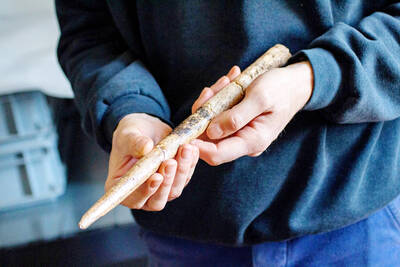It may be the most capitalist enterprise in Communist Vietnam — by the rich and for the rich: a proliferation of golf courses that is displacing thousands of farmers and devouring the rice fields the country depends on.
Until last year, according to experts who have done the calculations, licenses for new courses were being issued at an average of one a week, for a total of more than 140 projects around the country.
Promoters created the idea of a “Ho Chi Minh Golf Trail,” a series of eight courses whose label is as good a sign as any of where Vietnam seems to be headed — its heroic wartime past redefined as a sales pitch.
If all those projects were completed, the number of courses would approach that of golf-mad South Korea, where there are close to 200. It would still fall well short of China, which has more than 300, and would be nowhere near the number in the US, which has about 16,000 courses, or even Florida, with 1,260.
For a country that had only two courses at the end of the war in 1975 and that according to some estimates has only 5,000 golfers today, however, the increase in projects over the past four years has been explosive.
But a backlash emerged within the news media and among academics and government officials over the social and environmental costs.
In the summer of last year, Prime Minister Nguyen Tan Dung ordered a halt to new construction pending a review, and last June the government ordered the cancellation of 50 of the projects. But most of the others are well under way, to add to the country’s 13 established golf courses.
“Developers and foreign investors are saying they want to make the country a tourist destination, and to do that you need to offer more amenities like golf,” said Kurt Greve, the American general manager of the Ocean Dunes Golf Club and the Dalat Palace Golf Club. Most of those tourists would come from elsewhere in Asia, especially South Korea and Japan, where golf courses are hugely overcrowded.
“They’re all wanting to grow golf,” he said, referring to the developers and investors, “but the government is saying, ‘Whoa, whoa, whoa, wait a minute!’”
In its drive to industrialize, Vietnam has already lost large amounts of farmland to factories and other developments. According to the Agriculture Ministry, land devoted to rice, the national staple and a leading source of export revenue, shrank to 4 million hectares from 4.5 million hectares, just from 2000 to 2006.
Many of the new projects seem to have to do more with capitalism than with sport. Taxes on golf courses are lower than those on other forms of development, and many of the projects appear to be disguised real estate ventures.
Only 65 percent of the land involved in the current projects has been set aside for golf courses, Ton Gia Huyen, an official with the Vietnam Land Science Association, said at a conference on golf courses in May. The rest of the land is reserved for hotels, resorts, villas, eco-tourism areas, parks and recreational projects.
One solution is to change the tax structure, said Nguyen Dang Vang, vice chairman of the National Assembly’s Committee for Science, Technology and Environment.
“Golf courses are for rich people, account for vast areas of land, cause pollution and affect food security, so taxes should be appropriately high,” he told the newspaper Tuoi Tre in July.
And when rich people play, it appears that farmers and villagers pay the price.
Development of a single course can cost the land of hundreds of farms, displacing as many as 3,000 people, sometimes devouring an entire commune, Nguyen Duc Truyen, an official of the Vietnamese Academy of Social Sciences’ Institute of Sociology, said at the recent conference. Only a small number of them find jobs on the new golf courses.
For example, the Dai Lai golf course in Vinh Phuc province drove thousands of people from their land but provided jobs for only 30 local residents, according to a report in July on the Vietnam News Service. Farmers are typically compensated at a rate of US$2 to US$3 a square meter, the news service said, about the cost of a sack of rice.
Along with land, golf courses also put a strain on water resources, said Le Anh Tuan from the Can Tho University Environmental Technology Center. In a widely quoted estimate, he said an 18-hole course could consume 5 million liters of water a day, enough for 20,000 households.
“The dry season is critical,” said Kiet Tuan Le, the chief groundskeeper here at Ocean Dunes, 200km northeast of Ho Chi Minh City. “I’ve got to continually ask the water department, almost fight them, because there’s not enough water for the city people.”
Greve said that the resort was working to minimize its environmental impact, with a new strain of grass that was more salt-tolerant and would require less fresh water.
The nearby Sea Links Golf and Country Club, which is built on sand dunes, pipes in water from a source nearly 3km away, said one of the resort’s directors, Tran Quang Trung. Automatic sprinklers switch on every 15 minutes and individual hoses provide a continuing drip at the base of each tree.
The sumptuous, rolling 18-hole course is only one part of the ambitious, 170-hectare development, he said.
Rows of villas, 315 of them, stand behind the course like soldiers on parade, with many sold before they were built. A five-star hotel overlooking the course has almost been completed.
Just beyond the development area, the red earth is already being turned for the construction of six ocean-view apartment buildings with 550 units.
In the future, Trung said, it will all be known as “Sea Links City.”

June 2 to June 8 Taiwan’s woodcutters believe that if they see even one speck of red in their cooked rice, no matter how small, an accident is going to happen. Peng Chin-tian (彭錦田) swears that this has proven to be true at every stop during his decades-long career in the logging industry. Along with mining, timber harvesting was once considered the most dangerous profession in Taiwan. Not only were mishaps common during all stages of processing, it was difficult to transport the injured to get medical treatment. Many died during the arduous journey. Peng recounts some of his accidents in

A short walk beneath the dense Amazon canopy, the forest abruptly opens up. Fallen logs are rotting, the trees grow sparser and the temperature rises in places sunlight hits the ground. This is what 24 years of severe drought looks like in the world’s largest rainforest. But this patch of degraded forest, about the size of a soccer field, is a scientific experiment. Launched in 2000 by Brazilian and British scientists, Esecaflor — short for “Forest Drought Study Project” in Portuguese — set out to simulate a future in which the changing climate could deplete the Amazon of rainfall. It is

What does the Taiwan People’s Party (TPP) in the Huang Kuo-chang (黃國昌) era stand for? What sets it apart from their allies, the Chinese Nationalist Party (KMT)? With some shifts in tone and emphasis, the KMT’s stances have not changed significantly since the late 2000s and the era of former president Ma Ying-jeou (馬英九). The Democratic Progressive Party’s (DPP) current platform formed in the mid-2010s under the guidance of Tsai Ing-wen (蔡英文), and current President William Lai (賴清德) campaigned on continuity. Though their ideological stances may be a bit stale, they have the advantage of being broadly understood by the voters.

Artifacts found at archeological sites in France and Spain along the Bay of Biscay shoreline show that humans have been crafting tools from whale bones since more than 20,000 years ago, illustrating anew the resourcefulness of prehistoric people. The tools, primarily hunting implements such as projectile points, were fashioned from the bones of at least five species of large whales, the researchers said. Bones from sperm whales were the most abundant, followed by fin whales, gray whales, right or bowhead whales — two species indistinguishable with the analytical method used in the study — and blue whales. With seafaring capabilities by humans